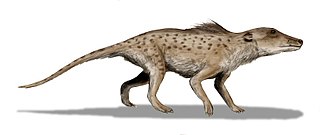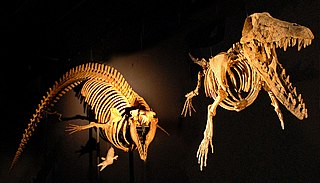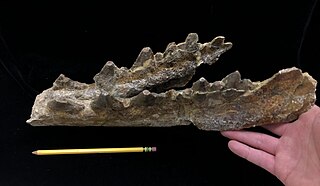
Rodhocetus is an extinct genus of protocetid early whale known from the Lutetian of Pakistan. The best-known protocetid, Rodhocetus is known from two partial skeletons that taken together give a complete image of an Eocene whale that had short limbs with long hands and feet that were probably webbed and a sacrum that was immobile with four partially fused sacral vertebrae. It is one of several extinct whale genera that possess land mammal characteristics, thus demonstrating the evolutionary transition from land to sea.

Pakicetidae is an extinct family of Archaeoceti that lived during the Early Eocene in Pakistan. Unlike modern cetaceans, they had well-developed limbs and were capable of walking.

Ambulocetus is a genus of early amphibious cetacean from the Kuldana Formation in Pakistan, roughly 48 or 47 million years ago during the Early Eocene (Lutetian). It contains one species, Ambulocetus natans, known solely from a near-complete skeleton. Ambulocetus is among the best-studied of Eocene cetaceans, and serves as an instrumental find in the study of cetacean evolution and their transition from land to sea, as it was the first cetacean discovered to preserve a suite of adaptations consistent with an amphibious lifestyle. Ambulocetus is classified in the group Archaeoceti—the ancient forerunners of modern cetaceans whose members span the transition from land to sea—and in the family Ambulocetidae, which includes Himalayacetus and Gandakasia.

Pakicetus is an extinct genus of amphibious cetacean of the family Pakicetidae, which was endemic to Indian Subcontinent during the Ypresian period, about 50 million years ago. It was a wolf-like mammal, about 1–2 m long, and lived in and around water where it ate fish and other animals. The name Pakicetus comes from the fact that the first fossils of this extinct amphibious whale were discovered in Pakistan. The vast majority of paleontologists regard it as the most basal whale, representing a transitional stage between land mammals and whales. It belongs to the even-toed ungulates with the closest living non-cetacean relative being the hippopotamus.

Archaeoceti, or Zeuglodontes in older literature, is a paraphyletic group of primitive cetaceans that lived from the Early Eocene to the late Oligocene. Representing the earliest cetacean radiation, they include the initial amphibious stages in cetacean evolution, thus are the ancestors of both modern cetacean suborders, Mysticeti and Odontoceti. This initial diversification occurred in the shallow waters that separated India and Asia 53 to 45 mya, resulting in some 30 species adapted to a fully oceanic life. Echolocation and filter-feeding evolved during a second radiation 36 to 35 mya.

Protocetus atavus is an extinct species of primitive cetacean from Egypt. It lived during the middle Eocene period 45 million years ago. The first discovered protocetid, Protocetus atavus was described by Fraas 1904 based on a cranium and a number of associated vertebrae and ribs found in middle Lutetian Tethyan marine limestone from Gebel Mokattam near Cairo, Egypt.
Himalayacetus is an extinct genus of carnivorous aquatic mammal of the family Ambulocetidae. The holotype was found in Himachal Pradesh, India, in what was the remnants of the ancient Tethys Ocean during the Early Eocene. This makes Himalayacetus the oldest archaeocete known, extending the fossil record of whales some 3.5 million years.

Ichthyolestes is an extinct genus of archaic cetacean that was endemic to Indo-Pakistan during the Lutetian stage. To date, this monotypic genus is only represented by Ichthyolestes pinfoldi.

Kutchicetus is an extinct genus of early whale of the family Remingtonocetidae that lived during Early-Middle Eocene in what is now the coastal border of Pakistan and India. It is closely related to Andrewsiphius with which it was synonymized by Gingerich et al. 2001. Thewissen & Bajpai 2009 proposed a new clade, Andrewsiphiinae, for the two species. Later authors, however, still accept both as separate genera.

Remingtonocetus is an extinct genus of early cetacean freshwater aquatic mammals of the family Remingtonocetidae endemic to the coastline of the ancient Tethys Ocean during the Eocene. It was named after naturalist Remington Kellogg.

Remingtonocetidae is a diverse family of early aquatic mammals of the order Cetacea. The family is named after paleocetologist Remington Kellogg.
Gaviacetus is an extinct archaeocete whale that lived approximately 45 million years ago. Gaviacetus was named for its characteristic narrow rostrum and the fast pursuit predation suggested by its unfused sacral vertebrae.

Attockicetus is an extinct genus of remingtonocetid early whale known from the Middle Eocene (Lutetian) Kuldana Formation in the Kala Chitta Hills, in the Attock District of Punjab, Pakistan.
Babiacetus is an extinct genus of early cetacean that lived during the late Lutetian middle Eocene of India . It was named after its type locality, the Harudi Formation in the Babia Hills, Kutch District, Gujarat, India.

Andrewsiphius is an extinct remingtonocetid early whale known from the Eocene of Gujarat and Kutch, India and Balochistan, Pakistan.

Indocetus is a protocetid early whale known from the late early Eocene Harudi Formation in Kutch, India.
Eocetus is an extinct protocetid early whale known from the early-late Eocene Giushi Formation in Gebel Mokattam, outside Cairo, Egypt. Fossil remains have also been discovered in the Aridal Formation of the Sahara Desert in southwestern Morocco.

Kharodacetus is a genus of protocetid cetacean from the middle Eocene of Kutch, Gujarat, southwestern India.

Johannes Gerardus Marie (Hans) Thewissen is a Dutch-American paleontologist known for his significant contributions to the field of whale evolution. Thewissen's fieldwork has led to the discovery of key fossils that have shed light on the transition of whales from land to water, including the discovery of Ambulocetus, Pakicetus, Indohyus, and Kutchicetus. In addition to his work on fossil discoveries, Thewissen also studies modern bowhead and beluga whales in Alaska, focusing on their biology and the implications of this knowledge for management and conservation efforts. His research has been instrumental in deepening our understanding of cetacean evolution and the adaptations that allowed these mammals to transition from terrestrial to fully aquatic lifestyles.
The Kuldana Formation is a fossil-bearing geological formation of Lutetian age which crops out in northern Pakistan. The abundant fossil remains were deposited by rivers and estuaries crossing an arid to semi-arid environment, between several marine transgressions. Its fossil fauna is best known for the early cetaceans Indohyus, Pakicetus and Ambulocetus, that helped to shed a new light on the evolution of whales, but it also features a large number of early ungulates, rodents and primates.













